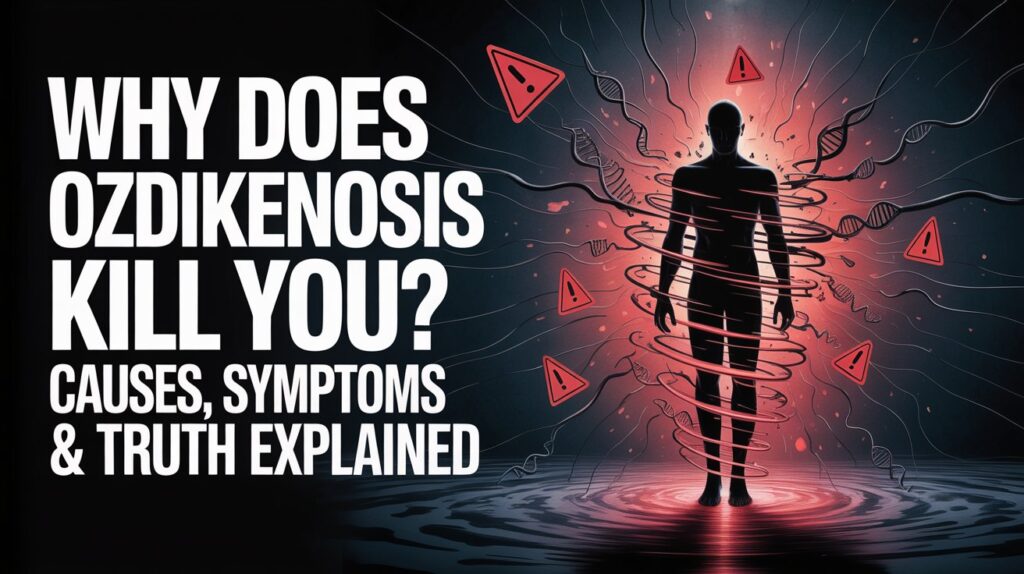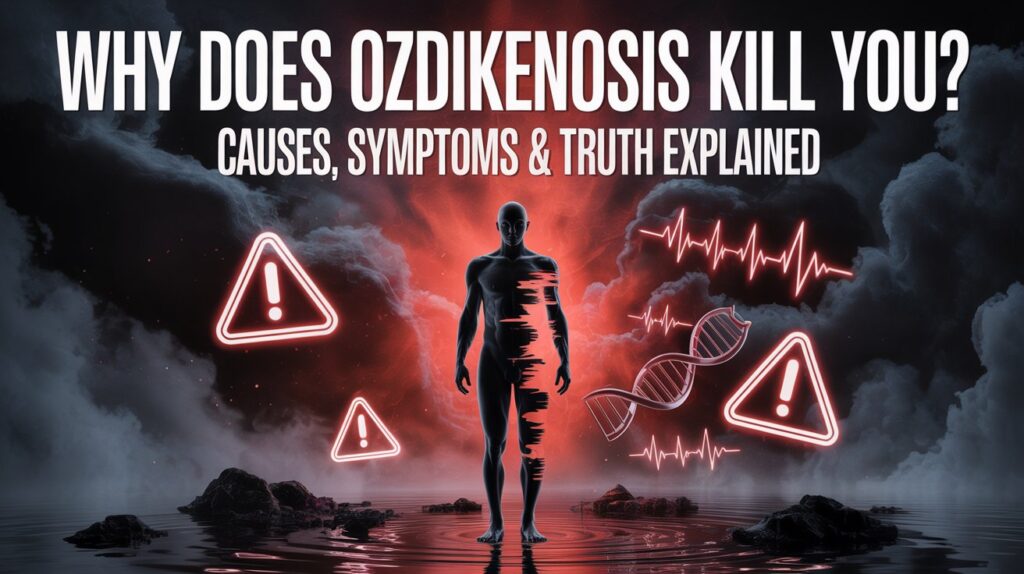Health information on the internet is powerful. A single search can connect people with potentially life-saving knowledge — or lead them down a path of confusion and misinformation. One term that has generated both curiosity and anxiety is ozdikenosis.
When readers encounter headlines like “Why does ozdikenosis kill you?” the implication is clear: this is something dangerous, mysterious, and perhaps fatal. Yet a closer look at the available content reveals inconsistencies. Some sites describe ozdikenosis as a deadly genetic disease, while others hint that the condition might not exist at all.
What Is Ozdikenosis?
Origins of the Term
Ozdikenosis has surfaced primarily in content farm websites and low-authority blogs. Its defining characteristics in those sources include:
-
A rare genetic basis.
-
Multi-system involvement.
-
Fatal outcomes, often in childhood or early adulthood.
However, it is not found in peer-reviewed journals, PubMed, the World Health Organization (WHO), or any national medical authority databases.
This lack of authoritative documentation makes it unlikely that ozdikenosis is a real, clinically recognized condition.
Why People Believe It Exists
Despite the lack of medical recognition, the term persists because:
-
Repetition: Multiple articles recycle similar phrasing, creating the illusion of consensus.
-
Human fear: Words like “genetic,” “rare,” and “fatal” naturally capture attention.
-
SEO-driven content: Some websites exploit medical keywords for traffic without verifying accuracy.
Possible Explanations
-
A misinterpretation: Ozdikenosis could be a garbled reference to a real disorder with a difficult name.
-
A fictional placeholder: It may have been invented to illustrate the dangers of rare diseases.
-
A misinformation cycle: Once published on a few blogs, it spread through copy-paste repetition.
Why Is Ozdikenosis Described as Fatal?
The Standard Narrative
Almost every article on ozdikenosis emphasizes its lethality. The descriptions follow a common medical storyline:
-
Cellular breakdown — cells fail to function normally.
-
Organ stress — tissues cannot sustain activity.
-
System-wide collapse — vital organs like the heart, lungs, or brain shut down.
-
Death — often described as inevitable.
Real Medical Parallels
While ozdikenosis lacks evidence, the mechanism mirrors fatal progressions seen in conditions such as:
-
Mitochondrial disorders (cells cannot generate enough energy).
-
Immune deficiencies (body cannot fight infections).
-
Genetic storage diseases (toxic substances accumulate in cells).
-
DNA repair syndromes (cells deteriorate rapidly due to genetic instability).
Why This Sounds Convincing
Because these mechanisms are medically accurate in other conditions, the narrative of ozdikenosis killing through organ failure seems plausible. That plausibility fuels continued belief.
Symptoms Linked to Ozdikenosis
Reported Symptoms in Online Sources
-
Fatigue and weakness
-
Growth stunting
-
Developmental delays
-
Frequent respiratory infections
-
Seizures or cognitive impairment
-
Organ enlargement (liver, spleen)
-
Difficulty breathing
-
Multi-organ dysfunction
Symptom Comparison Table
Ozdikenosis Symptom (Described Online) |
Comparable Symptoms in Real Disorders |
|---|---|
Fatigue, weakness |
Mitochondrial myopathies, muscular dystrophies |
Growth delays |
Schimke immuno-osseous dysplasia, hormonal syndromes |
Developmental delay, seizures |
Leigh syndrome, Rett syndrome |
Repeated infections |
Severe combined immunodeficiency (SCID) |
Enlarged liver or spleen |
Gaucher disease, Niemann–Pick disease |
Difficulty breathing |
Pulmonary fibrosis, cystic fibrosis |
Why These Symptom Lists Matter
By comparing ozdikenosis descriptions to real conditions, we can see that the symptoms are not unique. They are recycled features of well-documented rare diseases.
Diagnosing Complex Rare Disorders
Typical Steps in Diagnosis
When doctors investigate a suspected rare disease, they often use:
-
Comprehensive history and examination
-
Blood and urine tests for unusual metabolites
-
Genetic sequencing to detect mutations
-
Tissue biopsies to confirm cellular abnormalities
-
Imaging scans to evaluate organ size and damage
Why Ozdikenosis Lacks Diagnostic Pathways
Because ozdikenosis is not a verified disorder, there are no official criteria for diagnosis. No genetic markers, no biochemical tests, no imaging standards. This is one of the clearest signs that it is not recognized in medicine.
Treatment in Comparable Conditions
Supportive Care
-
Respiratory therapy
-
Dialysis
-
Pain management
-
Seizure control
Targeted Approaches
-
Enzyme replacement therapy (ERT): Gaucher disease, Pompe disease
-
Stem cell or bone marrow transplant: Immunodeficiencies
-
Gene therapy: Experimental treatments for single-gene disorders
Lifestyle Adjustments
Patients with metabolic disorders may rely on:
-
Specialized diets (low protein, low fat, or supplemented with key nutrients)
-
Avoidance of infection risks
-
Regular clinical monitoring
Prognosis and Survival
Why Online Sources Emphasize Death
The inevitability of death in ozdikenosis narratives may stem from:
-
Copying fatality statistics from real rare diseases
-
Dramatic effect to capture readers’ attention
-
Lack of nuanced discussion on treatment or variability
Real-World Prognosis of Similar Conditions
-
Mitochondrial disorders: Outcomes vary from early death to near-normal life spans.
-
Immune deficiencies: Some can be cured with bone marrow transplants.
-
Storage diseases: Lifespans are improving with modern therapies.
The Role of Medical Advances
Each decade, therapies improve. Conditions once uniformly fatal now have survivors living into adulthood. This is why blanket fatalism, as seen in ozdikenosis content, is misleading.
How Ozdikenosis Differs from Real Diseases
Comparative Table
Ozdikenosis |
Recognized Rare Disease |
|---|---|
Not found in PubMed or NIH |
Indexed with thousands of studies |
No diagnostic tests |
Genetic and biochemical tests available |
Treated as universally fatal |
Outcomes vary, treatments exist |
Originates from low-quality blogs |
Studied in top hospitals worldwide |
Consequences of Confusion
-
Creates unnecessary panic
-
Distracts from real rare disease advocacy
-
Undermines trust in legitimate rare disease research
Broader Lessons in Navigating Health Information
Why Misinformation Thrives
-
High emotional stakes
-
Low general knowledge of rare diseases
-
SEO incentives for publishers
How to Check Legitimacy
-
Search authoritative databases (NIH, PubMed, WHO)
-
Verify whether hospitals or research centers discuss it
-
Look for author credentials (MD, PhD)
-
Avoid sites with generic, unsourced claims
Patient Guidance
If your symptoms overlap with those attributed to ozdikenosis:
-
Document what you experience.
-
Visit a physician for proper evaluation.
-
Request referrals to specialists in genetics or rare disease medicine.
-
Seek patient advocacy organizations with established reputations.
Case Studies of Real Disorders Similar to Ozdikenosis
Mitochondrial Disease
-
Caused by defects in cellular powerhouses.
-
Leads to muscle weakness, brain dysfunction, organ damage.
-
Range from mild to fatal.
Schimke Immuno-Osseous Dysplasia
-
Rare genetic condition causing skeletal abnormalities, immune failure, kidney disease.
-
Incurable but studied actively.
Severe Combined Immunodeficiency (SCID)
-
Infants appear healthy but lack functional immune systems.
-
Without treatment, infections are lethal.
-
Bone marrow transplants have saved many lives.
Gaucher Disease
-
Lysosomal storage disorder.
-
Causes enlarged organs, bone pain, anemia.
-
Treatable with enzyme replacement therapy.
These examples show how the symptom profiles attributed to ozdikenosis actually match existing rare conditions.
FAQs
Q1: Is ozdikenosis officially recognized?
No, it is not listed in medical databases or scientific literature.
Q2: Why do articles say it kills you?
Because it mimics descriptions of real fatal conditions.
Q3: What should I do if I have similar symptoms?
Consult a healthcare provider, not online blogs.
Q4: Could ozdikenosis be a misnamed real disease?
Possibly. Its descriptions overlap with mitochondrial and storage disorders.
Q5: Are there treatments for such conditions?
Yes, though they vary — from supportive care to advanced gene therapies.
Q6: How do I avoid being misled?
Trust authoritative sources and seek professional medical evaluation.
Ethical Responsibility in Health Writing
Why Accuracy Matters
Mislabeling diseases can cause unnecessary distress for patients and families. It can also divert attention from genuine research and support needs.
The E-E-A-T Standard
-
Experience: Content grounded in real medical knowledge.
-
Expertise: Input from qualified professionals.
-
Authoritativeness: Backed by recognized institutions.
-
Trustworthiness: Transparent, accurate, responsibly written.
Conclusion
The phrase “why does ozdikenosis kill you” captures the anxiety many feel when confronted with health claims online. But the truth is straightforward: ozdikenosis is not a clinically recognized condition. Its descriptions borrow from real, devastating genetic disorders — but by repeating these features without context or evidence, low-quality websites have created confusion.
What matters most is not whether ozdikenosis is real, but how we handle such claims:
-
Check reliable sources.
-
Consult real medical professionals.
-
Protect yourself from misinformation.
For those truly living with rare conditions, the world of genetics and medicine offers both challenges and hope. Advances in therapy, earlier diagnosis, and stronger advocacy are transforming once-fatal prognoses. That hope should not be overshadowed by fictionalized conditions like ozdikenosis.
Next step for readers: If you are worried about symptoms or curious about rare diseases, consult a trusted healthcare provider or explore verified resources provided by medical institutions.













